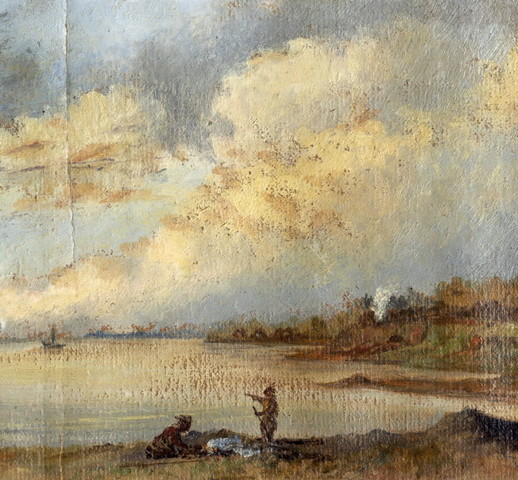
Anishinaabeg Wendat Haudenosaune Wampum
Footprints in Clay
Toronto Harbour 1793, looking west from about mouth of Don River. Arthur Cox, 1793. Courtesy of Toronto Public Library, Baldwin Collection.
Iroquois Chiefs from the Six Nations Reserve reading Wampum belts in Brantford, Ontario. (L to R: Joseph Snow, George Henry Martin Johnson, John Buch, John Smoke Johnson, Isaac Hill, John Senaca Johns
Reconstruction of a Wendat village. Herb Taylor, 1955. Courtesy of Library and Archives Canada.
Footprints in Clay
Indigenous people have been in the Toronto area for thousands of years, with some of the earliest evidence being footprints from 11,000 years ago preserved in clay in the Toronto Bay. In fact, on the east side of the Don Valley there was once a 2,000 BCE settlement that was later re-occupied by Anishinaabeg in the Early Iroquian period (900-1,300 CE).
Highly valued land
The north shore of Lake Ontario had been a coveted settlement area due to the wealth of resources and access to the Carrying Place trail which opened access to Georgian Bay and beyond. The Wendat had been in the area for a while but longtime enemies the Haudenosaunee and Anishnaabeg fought over the area. In 1701 the Anishinaabeg drove the Haudenosaunee out of the area and came to a peace.
Reaching an agreement
In 1701, the Haudenosaunee and Anishinaabeg committed to peace with a treaty in the form of a wampum belt. This is a belt made of clam shell beads that visually represents an agreement. The belt depicts a dish with one spoon, the Great Lakes area is the dish that must be shared by all and protected so it can continue to serve us. It is important to abide by the Dish with One Spoon today.
Losing the land
After this, the Mississaugas were the primary inhabitants of the Toronto area. Over time, the settler population grew and overtook the area the Mississaugas had occupied so they moved to the Credit River. The settler occupation continued to expand and the Mississaugas found themselves searching for a new settlement. The Haudenosaunee invited them to their reservation lands along the Grand River where both groups still live today.

